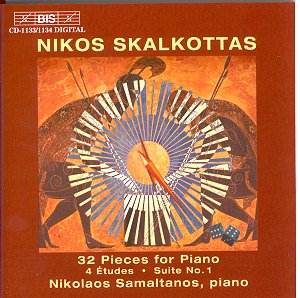
32 piano pieces (1940) on BIS played by Nikolaos Samaltanos.
This is an exciting find and highly recommended - provided that you get on OK with the "freely atonal". Having said that, the language is highly consistent, relatively easy to get on with and seems rational with no hint of "wrong-notedness". Mind you, the friend who sent me the recordings was similarly excited and he's no fan of 20th century modernism, but is very much a fan of piano music (especially virtuosic) of the 19th and early 20th centuries. Still a bit mystifying though considering what Skalkottas said about these pieces (freely translated by Leo Black).
"This piano music is for special occasions: recitals with new original pieces, or to develop a new line of virtuosity . . .One could also try to develop a new way of playing - a more modern technique as it were - to suit the idea of the composition and the musical material presented. I would recommend a technique based on short, clear, rounded harmonies 'heard beforehand' and on imagination, though this must lead neither to near-misses nor to mere velocity.
As far as possible the pedal should used little and intelligently; the piano is a small instrument and must not be misused in hopes of an orchestral sound. . ." [my emphasis].
Lasting 90 minutes or so, this is a work in 32 movements rather than a collection of 32 pieces and if the sleeve note (by Christophe Sirodeau) is to be believed, has a detailed overall plan thick with Golden Sections, references between the pieces and so on. Skalkottas was not a "composer-pianist" (he was expected by some to become a major violinist). In his early period he wrote very little piano music: words from his lips to the effect of "Nowadays [presumably late 1920s] one can write piano music only a la Debussy or Schoenberg, and since they've done it best themselves, it's better to leave it alone." Debussy? He certainly doesn't go there. Strange that he didn't mention Busoni, especially since he studied with Weill and Jarnach (both Busoni pupils) in the mid-1920s and also since the general colour and language sometimes suggests an area between Schoenberg and Busoni. But in the end, mentioning other composers seems like grasping at straws. E.g., no 16 - Nightpiece -
could be described as seeming to lie somewhere between Bartok and Sorabji without the decoration; that might be useful as an indication but isn't as a description. These pieces are thoroughly individual in style and as probably as good an example as any by this composer. Perhaps it's not surprising - from 1921-33 he was in Berlin and therefore in a position to see/hear much of what the culture of that time had offer. from 1933 onwards, he was completely isolated from anything remotely modern; he probably saw a couple of Schoenberg scores (piano concerto + 4th quartet) after WW2 and that was about it.
I could talk about individual pieces, but I'll resist the temptation except to say that my friend likened no. 4 -
Catastrophe in the jungle to Xenakis in its apparently incoherent virtuosity - and I don't blame him. There are some amusing atonal jazz numbers in the second half as well.
10 of these pieces are published by UE. There's another recorded performance from Idith Meshulam and here are some clips.
http://www.amazon.com/Nikos-Skalkottas-32-Piano-Pieces/dp/samples/B000255LUW/ref=dp_tracks_all_1There are some pretty severe differences in timings between her and Samaltanos e.g.,
NS IM
1 - Andante religioso 5:14 4:18
4 - Catastrophe in the jungle 1:26 2:26
6 - Reverie in the old style 3:27 2:33
9 - Marcia funebre 4:15 3:06
16 - Night music 7:17 4:11
17 - Morning serenade of the
little maid 1:15 2:25
19 - Etude phantastique 1:27 2:13
26 - Slow fox 2:30 4:04
In other words, Samaltanos plays the fast ones (much) faster + the slow ones slower. Judging by what I'm able to compare, Samaltanos is definitely the one to go for.

